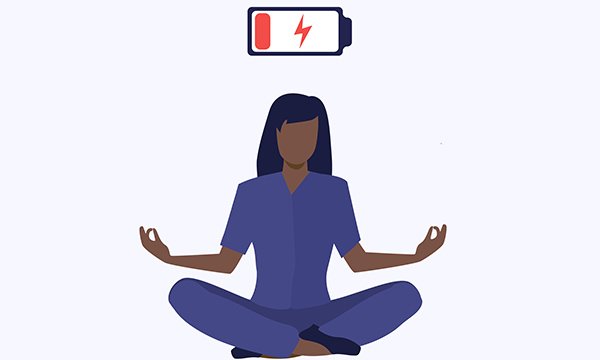Work-related stress is an ever-present challenge in today’s fast-paced and demanding professional environment. Whether it’s looming deadlines, challenging relationships with colleagues, or the pressure to constantly perform at your best, stress can take a toll on your mental, emotional, and physical well-being. Cognitive Behavioral Therapy (CBT), a well-established and evidence-based psychological treatment, offers a powerful toolkit for understanding and overcoming work stress. In this blog, we will delve into the techniques of CBT for work stress, providing you with practical strategies and insights to transform the way you cope with work-related challenges and foster a healthier work-life balance.
Contents
Can CBT Help With Work Stress?
 Yes, Cognitive Behavioral Therapy (CBT) is a highly effective treatment for managing work-related stress. It is based on the premise that our thoughts, feelings, and behaviors are interconnected. And, that changing negative thought patterns can lead to changes in feelings and behaviors. This is particularly relevant in the context of work stress, where pressures, deadlines, and interpersonal relationships can trigger a cycle of negative thinking.
Yes, Cognitive Behavioral Therapy (CBT) is a highly effective treatment for managing work-related stress. It is based on the premise that our thoughts, feelings, and behaviors are interconnected. And, that changing negative thought patterns can lead to changes in feelings and behaviors. This is particularly relevant in the context of work stress, where pressures, deadlines, and interpersonal relationships can trigger a cycle of negative thinking.
CBT helps individuals recognize their patterns of negative thinking, evaluate their validity, and develop healthier ways of thinking and responding. Through a range of strategies, individuals can learn to manage their stress response and reduce symptoms of anxiety and depression. Over time, CBT for work stress can contribute to a more balanced and resilient approach to work, promoting both mental health and productivity.
What Are The Techniques Of CBT For Work Stress?
Cognitive Behavioral Therapy (CBT) encompasses a variety of techniques to help individuals manage and reduce work stress. Here is a detailed overview of some key techniques of CBT for work stress that can be particularly effective:
Cognitive Restructuring
Cognitive restructuring involves identifying and challenging harmful thought patterns that contribute to stress. Individuals learn to recognize automatic negative thoughts related to their work. Such as “I’ll never get this project done on time” or “I’m not good enough for this job.” They are then taught to evaluate the accuracy and helpfulness of these thoughts, challenging cognitive distortions like catastrophizing (expecting the worst) or black-and-white thinking (seeing situations in only two categories instead of on a continuum).
Behavioral Activation
This technique encourages individuals to align their actions with their values and to engage in activities that bring them joy and satisfaction. It also involves breaking overwhelming tasks into smaller, more manageable parts and systematically addressing them. By doing so, individuals can build momentum, reduce feelings of helplessness, and foster a sense of accomplishment.
Problem-Solving
CBT teaches a structured approach to problem-solving, starting with clearly defining the issue at hand. Individuals then brainstorm potential solutions, assess the pros and cons of each, choose the most viable option, and take action. Following implementation, the outcome is reviewed to glean lessons for future problem-solving attempts. This approach helps reduce feelings of overwhelm and enhances a sense of control.
Mindfulness and Relaxation Techniques
 These techniques focus on reducing physical and mental tension. Deep breathing and progressive muscle relaxation are used to activate the body’s relaxation response, providing a counterbalance to stress. Mindfulness meditation encourages a non-judgmental awareness of the present moment, helping to break the cycle of stress reactivity and fostering a calm, focused mindset.
These techniques focus on reducing physical and mental tension. Deep breathing and progressive muscle relaxation are used to activate the body’s relaxation response, providing a counterbalance to stress. Mindfulness meditation encourages a non-judgmental awareness of the present moment, helping to break the cycle of stress reactivity and fostering a calm, focused mindset.
Exposure to Stressors
Gradual exposure involves confronting stress-inducing situations in a controlled and systematic way to build tolerance and resilience. Cognitive exposure, on the other hand, involves mentally rehearsing exposure to a stressful work situation, which can help reduce anxiety over time.
Building Resilience
Enhancing resilience involves developing a robust set of coping strategies to navigate stress. This includes fostering a growth mindset, where challenges are viewed as opportunities for learning and development, and cultivating positive relationships with colleagues, friends, and family to build a supportive network.
Assertiveness Training
This training focuses on improving communication skills, enabling individuals to express their thoughts and feelings clearly and respectfully. Learning to set and maintain healthy boundaries is also a crucial part of preventing work overload and managing stress.
Self-Monitoring
Keeping a stress diary can help individuals track their stressors, as well as their thoughts, feelings, and coping strategies. This self-reflection process aids in identifying patterns and making informed changes. Setting SMART (Specific, Measurable, Achievable, Relevant, Time-bound) goals also play a vital role in managing work stress.
Applying these CBT techniques consistently and with commitment can lead to significant improvements in managing work stress, enhancing overall well-being, and building resilience for future challenges.
How To Implement CBT In Daily Routine?
 Implementing Cognitive Behavioral Therapy (CBT) techniques into your daily routine can be a transformative practice, helping to manage stress, reduce negative thinking, and improve overall well-being. Here is a comprehensive guide on how to integrate CBT strategies into everyday life:
Implementing Cognitive Behavioral Therapy (CBT) techniques into your daily routine can be a transformative practice, helping to manage stress, reduce negative thinking, and improve overall well-being. Here is a comprehensive guide on how to integrate CBT strategies into everyday life:
Start with Self-Awareness
- Keep a Thought Journal: Document your daily thoughts, especially those that trigger stress or anxiety. Note down the situation, your automatic thoughts, the emotions they elicit, and the subsequent behavior.
- Identify Patterns: Over time, review your thought journal to identify recurring negative thought patterns or cognitive distortions.
Practice Cognitive Restructuring
- Challenge Negative Thoughts: When you notice a negative thought, ask yourself if it’s based on facts or assumptions. Evaluate the evidence for and against this thought.
- Reframe Your Thoughts: Replace distorted or unhelpful thoughts with more balanced, rational ones. Instead of thinking, “I can’t handle this,” try “This is challenging, but I can take steps to manage it.”
Build Behavioral Strategies
- Engage in Positive Activities: Make time for activities that bring you joy and satisfaction, which can act as natural stress relievers.
- Break Tasks into Smaller Steps: If a task feels overwhelming, break it down into more manageable parts and tackle them one at a time.
Cultivate Mindfulness
- Practice Mindfulness Meditation: Spend a few minutes each day focusing on your breath or sensations in your body, bringing your attention back whenever your mind wanders.
- Be Present: Try to be fully engaged in whatever you’re doing, whether it’s working, eating, or spending time with loved ones.
Foster Resilience
- Develop a Growth Mindset: View challenges as opportunities for growth and learning.
- Build a Support Network: Cultivate positive relationships with family, friends, and colleagues.
Set Realistic Goals
- Establish SMART Goals: Make sure your goals are Specific, Measurable, Achievable, Relevant, and Time-bound.
- Celebrate Small Wins: Acknowledge and celebrate your achievements, no matter how small.
Practice Self-Compassion
- Be Kind to Yourself: Treat yourself with the same kindness and understanding that you would offer to a good friend.
- Practice Gratitude: Regularly reflect on and express gratitude for the positive aspects of your life.
Consistency is Key
- Make It a Daily Practice: Consistently integrate CBT strategies into your daily routine, even on good days.
- Reflect and Adjust: Regularly reflect on what’s working and what’s not, and adjust your strategies accordingly.
By incorporating these CBT techniques into your daily life, you can develop a stronger, more resilient mindset, better equipped to handle the stresses and challenges of everyday living. Remember, like any new skill, these strategies require practice and patience. So be compassionate with yourself as you navigate this journey.
What Are The Limitations Of CBT For Work Stress?
 While Cognitive Behavioral Therapy (CBT) is widely recognized as an effective treatment for work-related stress and anxiety, it is not without its limitations. Understanding these constraints is essential for setting realistic expectations and exploring complementary therapies if necessary. Here are some of the potential limitations:
While Cognitive Behavioral Therapy (CBT) is widely recognized as an effective treatment for work-related stress and anxiety, it is not without its limitations. Understanding these constraints is essential for setting realistic expectations and exploring complementary therapies if necessary. Here are some of the potential limitations:
- Limited Depth in Addressing Underlying Issues
CBT is renowned for its efficacy in altering thought patterns and behaviors that contribute to stress and anxiety. However, its primary focus on present thoughts and behaviors means it might not delve as deeply into past experiences or underlying issues.
- Dependency on Active Participation
The effectiveness of CBT is contingent upon the individual’s willingness and ability to actively participate in the therapeutic process. This includes engaging in sessions, practicing strategies outside of therapy, and maintaining motivation throughout. Without a high level of commitment, the potential benefits of CBT may not be fully realized.
- Time and Consistency Required
Learning and applying CBT techniques effectively demands time and consistency. It is a skill-building process, and like any skill, it requires practice. Some individuals may experience frustration or impatience if they do not see immediate improvements.
- Possible Neglect of Emotional Processing
While CBT excels in restructuring thought patterns, it may sometimes underemphasize the importance of exploring and expressing emotions. For some individuals, integrating therapeutic approaches that provide space for emotional expression and processing could enhance their healing journey.
- Limited Exploration of Unconscious Processes
CBT primarily operates at the conscious level of thought and behavior change, potentially leaving unconscious processes unexplored. For some individuals, delving into these unconscious influences could provide valuable insights.
- Individual Differences
CBT is not a one-size-fits-all approach. Individual differences in preferences, learning styles, and cultural factors can impact the effectiveness of CBT. It is important for individuals to find a therapeutic approach that aligns with their values, preferences, and needs.
Understanding these limitations allows for a more realistic expectation of what CBT for work stress can achieve. And highlights the importance of a comprehensive and tailored approach to mental health.
Conclusion
In conclusion, while CBT for work stress stands as a robust and effective intervention, recognizing its limitations is paramount in ensuring a well-rounded approach to mental well-being. Its strengths lie in its structured nature, evidence-based strategies, and focus on altering detrimental thought patterns and behaviors. However, its potential drawbacks and its limitations in addressing deeper or external stressors, necessitate a thoughtful and informed approach.
By being aware of these aspects, individuals can set realistic expectations, seek complementary therapies when needed, and proactively engage in their journey towards stress management and mental resilience. If you are experiencing stress-related issues, Online Stress Counseling in India at TherapyMantra can help: Book a trial Online therapy session


